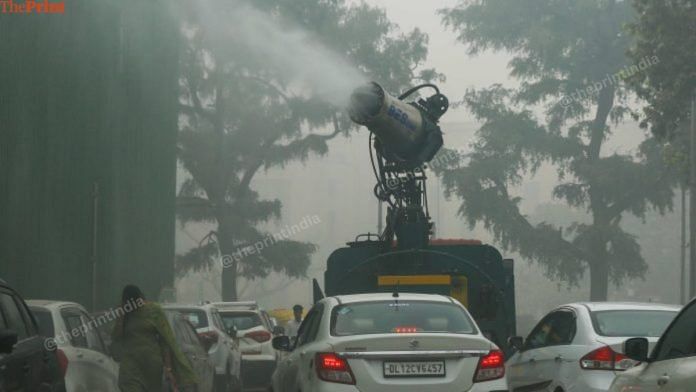New Delhi: The Commission for Air Quality Management (CAQM) Friday said all diesel vehicles older than 10 years and petrol vehicles older than 15 years shall be denied fuel in Delhi’s petrol pumps from 1 July.
The statutory body said cameras had been installed to ensure the implementation of this rule.At a press briefing, the CAQM said that Automatic Number Plate Recognition (ANPR) cameras had been installed at all of Delhi’s 520 fuel stations to start identifying these end-of-life (EoL) vehicles.
“These vehicles, which are mainly BS-IV (Bharat Stage Emission-IV) and under, cause a significant amount of pollution on Delhi’s roads, and our new direction is a step towards clean mobility in Delhi,” Virinder Sharma, CAQM member (technical), said at the press conference.
The initial order (Direction 89) to deny fuel to end-of-life polluting vehicles by 1 July was passed by CAQM on 23 April this year. The move had been earlier announced by Delhi Environment Minister Manjinder Sirsa, who said it would come into force from 31 March, but it was pushed to ensure more time to ensure fuel stations were equipped with ANPR cameras.
Once these vehicles have been identified, the Delhi Traffic Police and Delhi Transport Department will work together to take “immediate legal action” and impound the vehicles at the earliest, Sharma further added.
The CAQM said the owners of these vehicles could also get a No Objection Certificate (NOC) from the Delhi Transport Department, which will allow them to ply the vehicles anywhere but Delhi. However, fuel will not be provided to these vehicles at any fuel station in the National Capital Territory of Delhi.
There are 100 enforcement teams made up of officials from the traffic police and transport departments that will manage the implementation. The information from ANPR cameras will be matched with the VAHAN Dashboard, a flagship e-governance application under the Centre’s National Transport Project.
The data will then be shared with a central command centre managed by the Delhi Traffic Police, which will then take further action.
The national capital region (NCR) has some of the poorest air quality in the world, and studies, like one conducted by IIT Kanpur in 2024, have said local vehicle and traffic emissions are the largest contributors to it.
While the implementation will start in NCT, from 1 November onwards, it will extend to 5 locations in NCR—Gurugram, Faridabad, Ghaziabad, Gautam Buddh Nagar, and Sonipat.
The CAQM also plans to extend it to the entirety of NCR from 1 April 2026. “We’ve had meetings with fuel companies to ensure their stations follow these orders strictly. We’ve also been in talks with the transport department and Delhi Traffic Police, which will handle the action taken against EoL vehicles,” said Sharma.
Also Read: Delhi’s air was toxic for 56% of the days in last 5 years, AQI no reliable measure—CAG report
After numerous directions & a pilot project
The order to deny fuel to EoL vehicles from plying on Delhi’s roads came after numerous advisories and directions by the National Green Tribunal, and Supreme Court of India, the Union Ministry of Environment, Forests and Climate Change, and the Government of the National Capital of Delhi.
“There have been many attempts to enforce this order, but the implementation was lacking. We’re confident that now with our technological interventions like the ANPR cameras, and meeting with fuel companies, and our pilot project, we can implement it well,” said Sharma.
The pilot project of ANPR cameras started in December 2024, with around 100 cameras installed in Delhi. According to the CAQM, 3.62 crore vehicles were screened from then to June 2025, and 4.9 lakh end-of-life vehicles were identified.
“We have impounded 44,000 EoL vehicles as of March 2025, as part of the pilot project,” said Sharma. “It was an attempt to show that our systems are working.”
According to data from the VAHAN Dashboard, there are over 61 lakh end-of-life vehicles registered in Delhi, out of which 41 lakh are two-wheelers. Four-wheelers are 18 lakh, and the rest are other passenger and commercial vehicles.
“A BS-IV vehicle emits four times higher PM2.5 particles than a BS-VI vehicle,” he added.
Reacting to the announcement, Tutu Dhawan, an automobile expert, said that people must follow the rule if it is implemented. “Step by step, we need to support the government and policymakers on the road towards being carbon neutral.”
Dhawan also talked about vehicle scrapping facilities coming up in Delhi-NCR. “There’s new facilities in Noida and in and around Delhi. But the point isn’t even to scrap all cars, it’s to remove them from the road.”
“Whether that means taking it to a scrapping yard right away or to a garage or compound to keep it inactive, depends on the users,” he added.
(Edited by Sanya Mathur)
Also Read: ‘Pollution under control’ at Rs 50. Inside Delhi’s murky system of vehicular emission checks







This is one more scheme in the long list of a 100% corruption scheme.